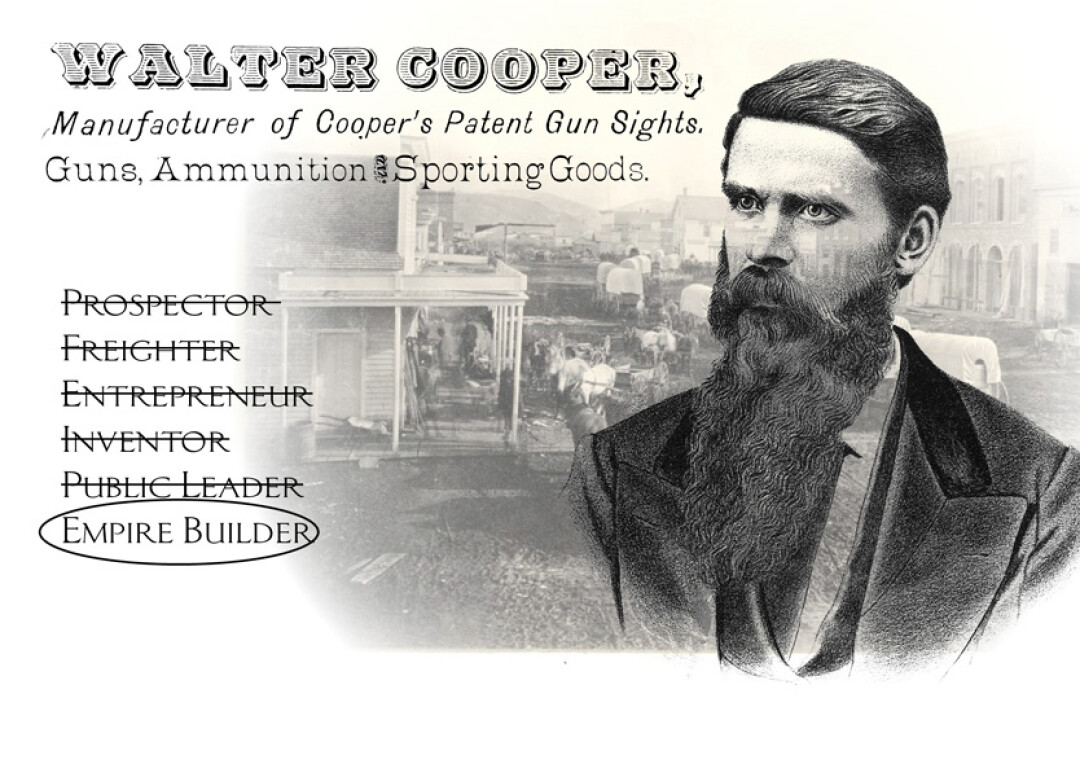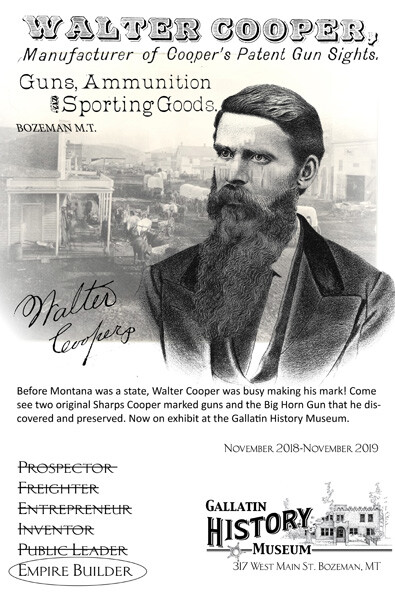The Lasting Legacies of Walter Cooper
Prospector, Freighter, Entrepreneur, Inventor, Public Leader, Empire Builder
Cindy Shearer | Monday Dec. 31st, 2018
 Walter Cooper was born Independence Day, 1843, in Sterling, New York, the third of six sons to Andrew and Sarah Cooper. By 1845 they had moved to Shiawassee County, Michigan, where tragedy struck the family in 1851 when a boat carrying Andrew and a load of his horses capsized on Lake Michigan. Initially surviving the accident, Andrew soon developed pneumonia and died leaving, behind a wife and six sons; his son Walter was eight years old.
Walter Cooper was born Independence Day, 1843, in Sterling, New York, the third of six sons to Andrew and Sarah Cooper. By 1845 they had moved to Shiawassee County, Michigan, where tragedy struck the family in 1851 when a boat carrying Andrew and a load of his horses capsized on Lake Michigan. Initially surviving the accident, Andrew soon developed pneumonia and died leaving, behind a wife and six sons; his son Walter was eight years old.
Walter was sent to live with a maternal aunt and his mother returned to New York with the younger children. By twelve years of age, Walter ran away to work the lumber camps and farms of northern Michigan. In 1858, at fifteen years old, Walter started west, arriving in Leavenworth, Kansas in November and then continuing on to Colorado where he joined a prospecting expedition to the San Juan Mountains and eventually traveled to Mexico. It was on this great adventure that he wrote of meeting Jim Bridger in Kansas and later Kit Carson in Taos, New Mexico.
At nineteen years of age, Walter was acting as a scout for the First Colorado Regiment until his next adventure landed him in Virginia City in February of 1864, where he engaged in mining at Alder Gulch for a few months. He was more interested in freighting supplies than mining and headed north to Fort Benton to meet the steamboats, expecting to return to Virginia City with supplies. Unfortunately, the water was so low in the Missouri River that little freight reached Fort Benton, so instead of returning to Virginia City with a wagon train full of materials and supplies, he returned empty handed, disposed of his train and outfitted himself with supplies for winter. Walter would spend the winter of 1864-65 hunting in the Missouri River valley before returning to mining with varying success until the fall of 1869, when he settled in Bozeman. He would remain in Bozeman until his death.
Cooper initially established a firearms and sporting goods house located on the north side of Main Street between Bozeman and Black. He was quoted as stating, “The first house of this kind started in the State or rather Territory of Montana for handling and manufacturing guns, ammunition, and fishing tackle.” Always a forward thinker, in 1872, Walter initiated construction of a large brick building at 118 E. Main Street, confident that the newly established Yellowstone National Park would spark interest and growth in this fledgling community. With bricks provided by William Tracy, who had recently purchased a brick-molding machine, the Cooper/Black building, completed a year later, was a testament to the optimistic spirit of these first entrepreneurs.
A story from Walter’s diary dated October 1871 sheds an interesting light on the daily goings-on during this same time period. “The Nez Perce Indians with 225 lodges under Chief Looking Glass reached town yesterday and a lively trade followed. Last night about a dozen of the young bucks, among whom was Whitebird who was about the store most the day got ahold of some whiskey.” He went on to explain that shots were fired, and the activities caused concern among the area families. A public meeting was held and Walter along with Jack Mendenhall and Lester S. Willson were asked to call upon Chief Looking Glass and request that he keep his young men out of town at night. Cooper described in detail the initial introduction to Chief Looking Glass. “The chief was a tall powerful man, a perfect athlete, every inch a chief. He wore no ornament of any kind, his dress extremely plain.” Following the description of the “problem,” Chief Looking Glass advised the trio that the true problem laid with the locals that provided the whiskey and that if they solved their “problem,” he would solve his.
By the end of 1873, the first brick commercial building was occupied by L. M. Black’s mercantile, a meat market, a drug store, and Cooper’s very own Armory and Gun Manufactory, which sold Sharps, Winchester, and Remington rifles, and Colt revolvers. Advertisements from January 1877 in the Avant Courier simply state Walter Cooper, Brick Block Bozeman M. T. (Territory) “My stock of sporting goods were selected by myself, and are all particularly adapted to the wants of Eastern Montana, Call and inspect my stock.” Employing as many as twelve skilled gunsmiths, Cooper’s sophisticated operation repaired and manufactured numerous weapons, including the 50-caliber Sharps Buffalo Gun, the most famous long-range rifle ever used in the West.
While his first order from the Sharps Company was in 1871 and the Armory and Gun Manufactory was listed as the number one purchaser of Sharps in Montana, much of this period Cooper was in debt to the Sharps Company. Sharps refused to ship him rifles directly or on consignment through other dealers for at least the years of 1874 to 1878. By 1878 his debt to Sharps totaled $1500; it was at this time that Walter’s friend, Nelson Story, bought the store with a partner, picking up Cooper’s debts with the deal. Story and Goewey owned the store for 27 months, after which time Cooper bought it back and reopened it under the name “Cooper’s Armory.” In his final advertisements that ran from 1881 to 1884, there was no mention of the Sharps Company.
A thorough knowledge of the wants of trappers, hunters, and mountain men led to Cooper’s introduction of many important improvements in firearms. Cooper was awarded a patent on November 14, 1882 for a rifle sight which consisted chiefly of a knife blade front sight with two or more lateral projections one above the other on either side. Cooper felt that this would alleviate the problem of having to move the rifle from the shoulder to adjust an elevation device on the rear sight for various distances. In all, Cooper is known to have invented eight different sights, but only one was awarded a patent. 
By the mid-1870s, Cooper had become one of the most extensive fur and buffalo hide traders in Montana. Bozeman became the second largest shipping point in Montana for fur, robes and hides that Cooper purchased from area trappers, hunters and Native Americans. Determined to profit, Cooper transported the sought-after commodities to St. Louis, winning recognition as one of the first to utilize steamboats for commercial purposes on the Yellowstone. For nearly a decade, he did an immense business.
By the early 1880s, however, hunters had decimated the buffalo herds and Cooper turned to other profitable enterprises. Recognizing the opportunities present by the recent arrival of the Northern Pacific, he obtained control of the Rocky Fork coal fields in Carbon County, helped developed the townsite of Red Lodge, and constructed the Rocky Fork and Cooke City Railroad. Over the years, he organized a company to supply water to Bozeman (Bozeman Water Works Company), which he later sold to the City of Bozeman, headed one of the largest flour mills in the state (Bozeman Milling Company), and continued prospecting for gold (Bozeman Gold and Silver Mining Company).
While gold prospecting had been a bust for many, enough gold was being mined to convince Northern Pacific to run its rail line through Bozeman. March 1883 was an important month in the history of Bozeman. Many citizens, including Cooper, who had been recently elected the first president of the Board of Trade, joined in celebrating train service to Bozeman. Within days the town incorporated and along with Nelson Story and John Dickerson the entire neighborhood between South Third and South 11th Avenues were platted and called the “Park Addition.” This included a 6-acre parcel, set aside in the midst of the building boom, and gave Bozeman its first city park, Cooper Park.
Following Montana’s 1889 admission to the Union, Cooper served as a delegate to the state Constitutional Convention. Cooper was a leading Democrat in the state and a strong voice in bringing the Agricultural College to Bozeman and was appointed to the local board overseeing the formation of the college. One hundred and thirty-nine students were enrolled by 1896 at the Montana State College of Agriculture and Mechanic Arts.
Shortly after the turn of the last century, Cooper established extensive lumbering operations on the Taylor’s Fork. During the spring runoff, his employees floated railroad ties and saw logs down the Gallatin River to Central Park, where a large sawmill processed the harvest and prepared it for shipment by rail. Incredibly, Cooper’s operations produced some two and one-half million railroad ties prior to 1907.
By 1911, Walter was sixty-eight years old and should have been enjoying and reflecting on a productive and rewarding life. Unfortunately, his substantial landholdings in Bozeman that had been secured by loans were draining his finances. Having accepted a loan from his long-time friend from Butte, Senator W. A. Clark to purchase fifty-six lots in Bozeman, Walter subsequently used those properties as collateral for another loan from the Commercial Bank of Bozeman and was sued by both parties. After a lengthy legal battle, his properties were foreclosed on and Cooper’s extensive landholdings in Bozeman were gone.
Walter Cooper passed away in Bozeman on April 24, 1924. Reported cause of death was “a general breakdown” at almost eighty-one years of age. Cooper was survived by his wife and daughter, two granddaughters and three brothers. His story of travels, adventures, risk taking, civic responsibility and entrepreneurship continue to be told. The brick Cooper/Black Building in downtown Bozeman still has retail operations, Cooper Park is loved by neighbors and dogs alike, the cornerstone on Montana Hall bears his name, and if you are a collector who owns a Sharps rifle with authentic Walter Cooper markings, you can be sure that you have a rifle that saw exciting adventures on the plains of Montana Territory in the days of the buffalo.
Before Montana was a state Walter Cooper was making his mark! Come see two original Marks Cooper marked guns and the Big Horn Gun he discovered and preserved now on exhibit at the Gallatin History Museum.
| Tweet |
